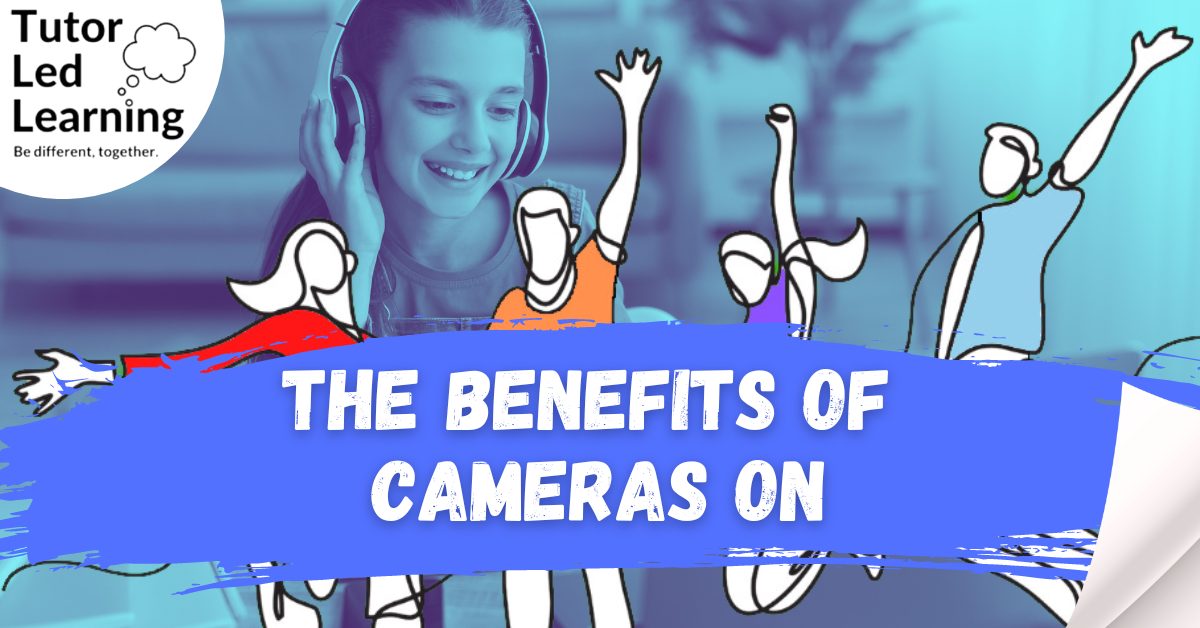
Do learners in online tutorials really benefit from having cameras on? Absolutely!
Looking for a different approach to education? Get in touch to see how we can support your home education journey.

Whilst many learners use their cameras in our tutorials, some don’t. At Tutor Led Learning, we believe that the best learning relationships happen when learners and tutors can see one another and they know their interactions are not being recorded. Using cameras is not compulsory at KS3 level, but Tutor Dave shares why he thinks learners having their cameras on is so valuable.
One of the best things about teaching is the look on a student’s face when they grasp a new concept or realise that they have finally mastered a challenging skill. It’s an expression that mixes pride, happiness and a dawning realisation that they can develop new skills, acquire new knowledge and shape the kind of person they want their future self to be. It’s what makes teaching special and it’s why we become teachers in the first place: to help young people be the best they can be.
…there is something that can be lost in an online environment: actually seeing our students, and students seeing each other.
Tutor Dave
I saw this expression a lot as I travelled around different homes, tutoring small groups after I first left my job in a secondary school. And in the early stages of finding my feet as a tutor, seeing the difference I could make was what motivated me to keep going.
The educational landscape is changing, though. I no longer travel to students’ homes and instead teach students all over the UK and in different countries online. Many home-educating families know that learning online is a great way to find the right tutor because geography need not be a barrier. If a tutor is in roughly the right time zone, then there’s no reason not to give them a try!
But whilst there are many advantages to working online (being able to give live feedback on shared documents, keep all our work safe and secure in online classrooms and easily share useful links to articles and videos to name just a few) there is something that can be lost in an online environment: actually seeing our students, and students seeing each other.
From what I have seen, having their camera on really enhances a students’ experience. Here’s why I think those students who don’t use their cameras should consider it…
It may seem unlikely online, but after a while, a real sense of community starts to develop and students feel like they know one another properly
Tutor Dave
In my English tutorials, I find that when students can see each other, they are far more likely to interact with one another verbally or via the chat box. This is great for students because they can build relationships over long distances and I even know of students who have met in lessons and then travelled to meet up face-to-face; it’s hard to imagine this happening without them having seen one another.
It may seem unlikely online, but after a while, a real sense of community starts to develop and students feel like they know one another properly (rather than just being faceless names on a video call). They love to share stories about their pets, holidays, birthdays and sympathise with one another if they have been off ill. Despite being online, having cameras on makes our lessons a highly sociable and friendly environment that just isn’t the same if students can’t see each other.
When students have cameras on, it far more closely recreates the atmosphere of a small group learning together in one location, just like being back around the kitchen table at one of my early home-educating families. Conversation flows more naturally and younger students, who are often really eager to share ideas, learn to respond to visual cues from others in the group to know when the time is right to jump in with their ideas; a key skill for later life, which some adults have yet to master!
Often in English, we need to talk in a thoughtful way about a character’s motives or an author’s intentions. Opinions often vary about these things and it is great for students to hash out their ideas with one another. Seeing how other students react to what they are saying and learning how to respond to those reactions is, in my view, a hugely important part of learning to be a successful communicator when they grow up.
Aside from the somewhat selfish reason of loving to see that expression that says ‘I learnt something new!’ on a student’s face, there are some clear positives for a tutor of being able to see their student.
Seeing a student allows us to identify when they need help more easily, to gauge their reaction to a new idea or concept, and to see if they have found our (probably terrible) jokes amusing. We get to know them as people and this is surely the essence of great tutoring: understanding another human being enough to be able to work out what the right thing to say or do is that helps them progress.
It’s knowing when to say something to offer support, and knowing when to stay silent because you can see the concentration in their faces. It’s knowing which students enjoy a little banter, and which students feel a bit embarrassed.
All students are different, and so being able to see how they react differently in lessons allows tutors to adapt our teaching to respond to what the students need.
Tutor Dave
All students are different, and so being able to see how they react differently in lessons allows tutors to adapt our teaching to respond to what the students need. Young people don’t always say if they are unsure about something, so being able to read their expressions allows us to try another explanation or clarify key information without them having to say they don’t understand.
It’s also important for us to be able to judge the mood of our students. We like to make our students feel welcome and happy in our lessons and it’s important for us to respond sensitively to their emotions. If a student has their camera on, we can often see what sort of mood they are in and then adjust the tone of our voice, the questions we ask and the praise we give to help put them in the best frame of mind possible. It means that we can respond in an emotionally intelligent way to our students more easily and try to ensure that their experience of education is as positive as it can be.
Reasons why a student might not want their camera on
Although I am clearly a fan of having cameras on, that’s not to say that I don’t understand there are reasons why some students prefer not to use them.
Perhaps a student has low self-esteem, has been subjected to bullying in the past, or believes that the way they dress will affect the opinion others in the group have of them. These are reasonable concerns for a young person to have and, for that reason we do not insist on having cameras on in our KS3 group tutorials, but encourage the use of them.
It’s a little different at KS4. When we are taking students through a GCSE, it really is essential that we can see them in order to teach effectively, so we do insist on cameras being on at this level.
Encourage camera use if you can
If you have a child learning online, experience tells me they will get the most from their lessons with their camera turned on. Have a chat with your child about whether they use their camera or not and, if they don’t, encourage them to give it a go. Most students who start using them leave them on in subsequent lessons even if they were nervous at first. Our groups are friendly places so they are a great opportunity to start building up camera confidence.
Tutor Dave (MA, PGCE)
Be different, together.
